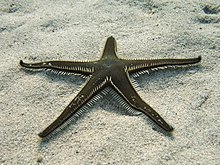
Starfish or sea stars are star-shaped echinoderms belonging to the class Asteroidea. Common usage frequently finds these names being also applied to ophiuroids, which are correctly referred to as brittle stars or basket stars. Starfish are also known as asteroids due to being in the class Asteroidea. About 1,900 species of starfish live on the seabed in all the world's oceans, from warm, tropical zones to frigid, polar regions. They are found from the intertidal zone down to abyssal depths, at 6,000 m (20,000 ft) below the surface.

Astropecten is a genus of sea stars of the family Astropectinidae.

Astropecten polyacanthus, the sand sifting starfish or comb sea star, is a sea star of the family Astropectinidae. It is the most widespread species in the genus Astropecten, found throughout the Indo-Pacific region. The armspread is up to 20 cm (8 in). The specific epithet "polyacanthus" comes from the Latin meaning "many thorned".
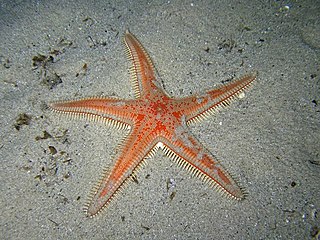
Astropecten aranciacus, the red comb star, is a sea star of the family Astropectinidae. It is native to the east Atlantic Ocean and the Mediterranean Sea.

Astropecten irregularis is a sea star of the family Astropectinidae. Common names include Sand sea star.

Astropecten platyacanthus is a sea star of the family Astropectinidae.

Astropecten jonstoni is a sea star of the family Astropectinidae.

Astropecten spinulosus is a sea star of the family Astropectinidae.
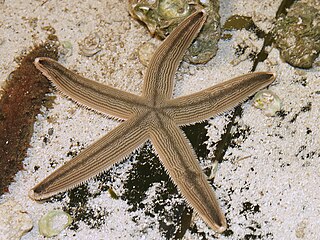
Luidia clathrata is a tropical species of starfish in the family Luidiidae. It is variously known as the slender-armed starfish, the gray sea star, or the lined sea star. It is found in the western Atlantic Ocean.

Luidia senegalensis, the nine-armed sea star, is a tropical species of starfish in the family Luidiidae found in the western Atlantic Ocean.

Luidia foliolata, the sand star, is a species of starfish in the family Luidiidae found in the northeastern Pacific Ocean on sandy and muddy seabeds at depths to about 600 m (2,000 ft).

Ophiura albida is a species of brittle star in the order Ophiurida. It is typically found on the seabed in the north eastern Atlantic Ocean and in the Mediterranean Sea and is sometimes known as the serpent's table brittle star.

Astropecten scoparius is a sea star in the family Astropectinidae. It is found in shallow water in the East China Sea and around the coasts of Japan. It is a grey starfish and each of its five arms has a narrow pale margin. It burrows in the muddy sediments on the seabed and feeds on molluscs.

Astropecten armatus, the spiny sand star or Estrella de Arena, is a sea star in the family Astropectinidae. It is found on sandy or gravelly areas in the East Pacific ranging from California (USA) to Ecuador.
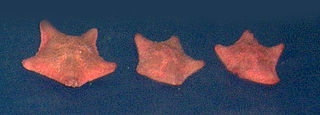
Asterina gibbosa, commonly known as the starlet cushion star, is a species of starfish in the family Asterinidae. It is native to the northeastern Atlantic Ocean and the Mediterranean Sea.

Astropecten duplicatus, the two-spined sea star, is a starfish in the family Astropectinidae. It is found in the eastern Atlantic Ocean, the Caribbean Sea and the Gulf of Mexico.

Marthasterias is a genus of starfish in the family Asteriidae. Both species in the genus are commonly known as the spiny starfish.
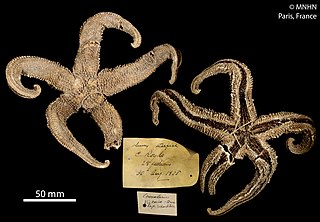
Diplasterias brucei is a species of starfish in the family Asteriidae. It is found in the Pacific Ocean and Southern Ocean. It is a predator and scavenger and is unusual among starfish in that it broods its young.

Coscinasterias muricata is a species of starfish in the family Asteriidae. It is a large 11-armed starfish and occurs in shallow waters in the temperate western Indo-Pacific region.

Asterina pancerii, commonly known as the seagrass asterina, is a species of starfish in the family Asterinidae. It is native to shallow parts of the Mediterranean Sea where it is usually found in seagrass meadows.
